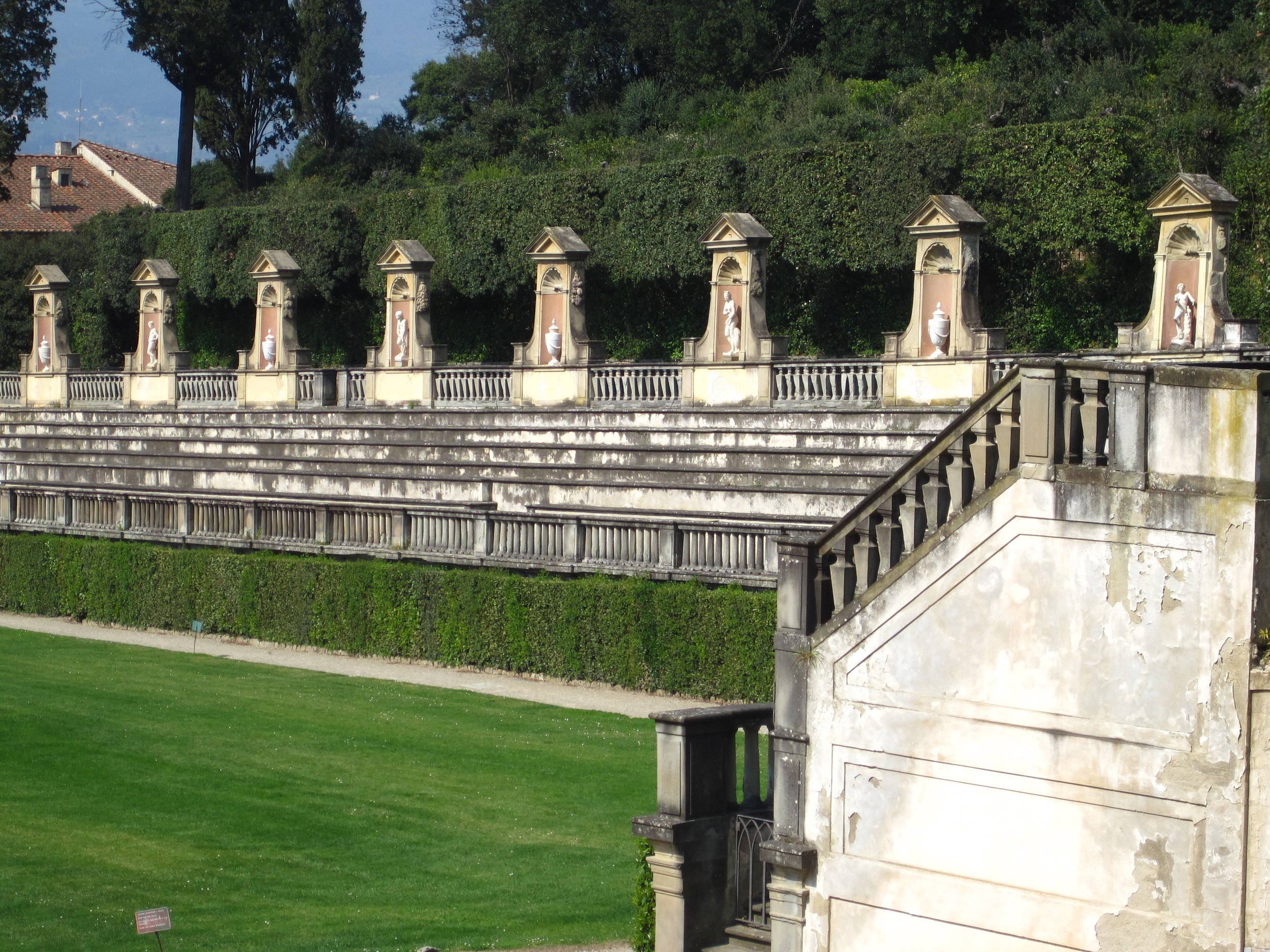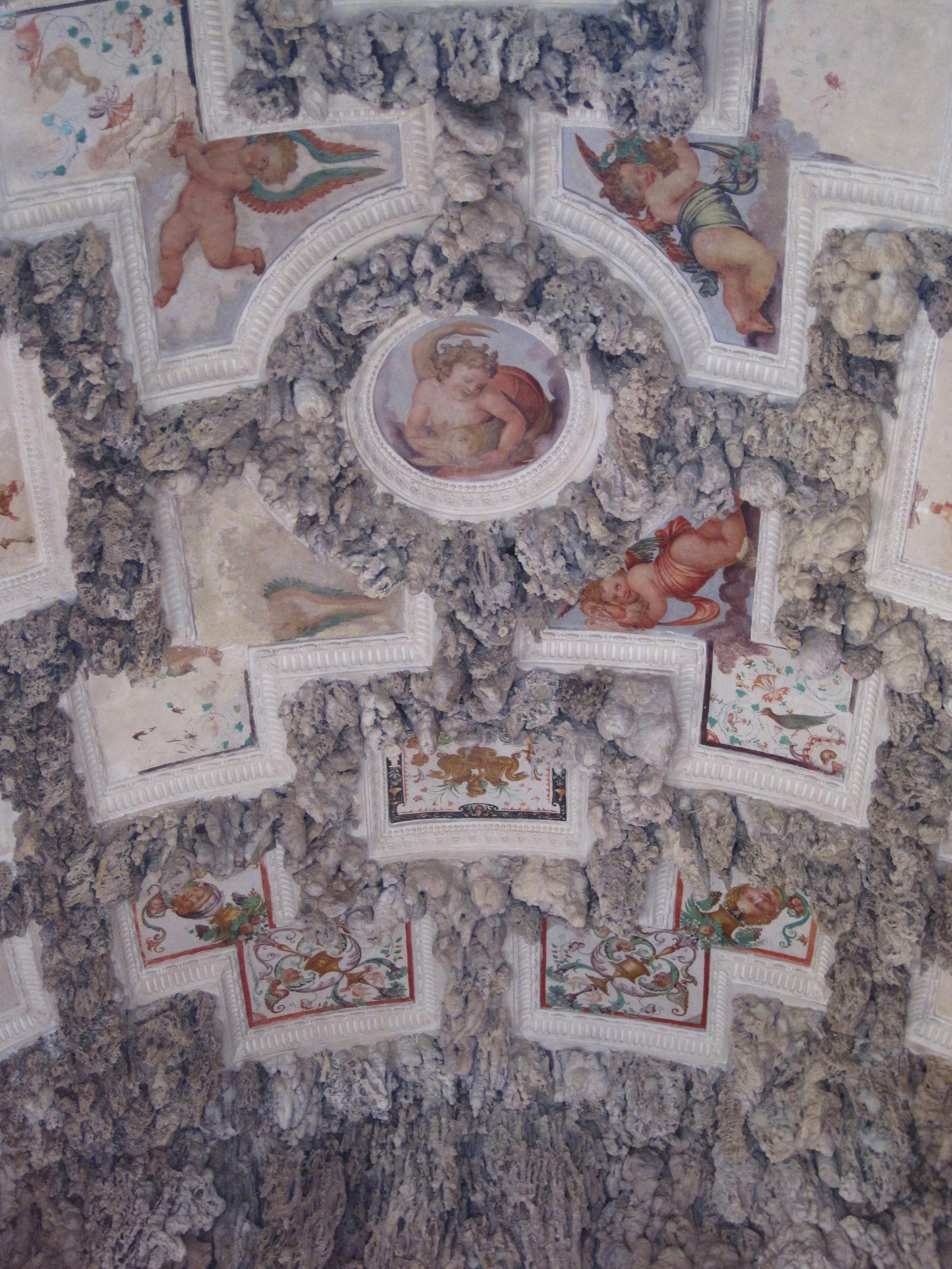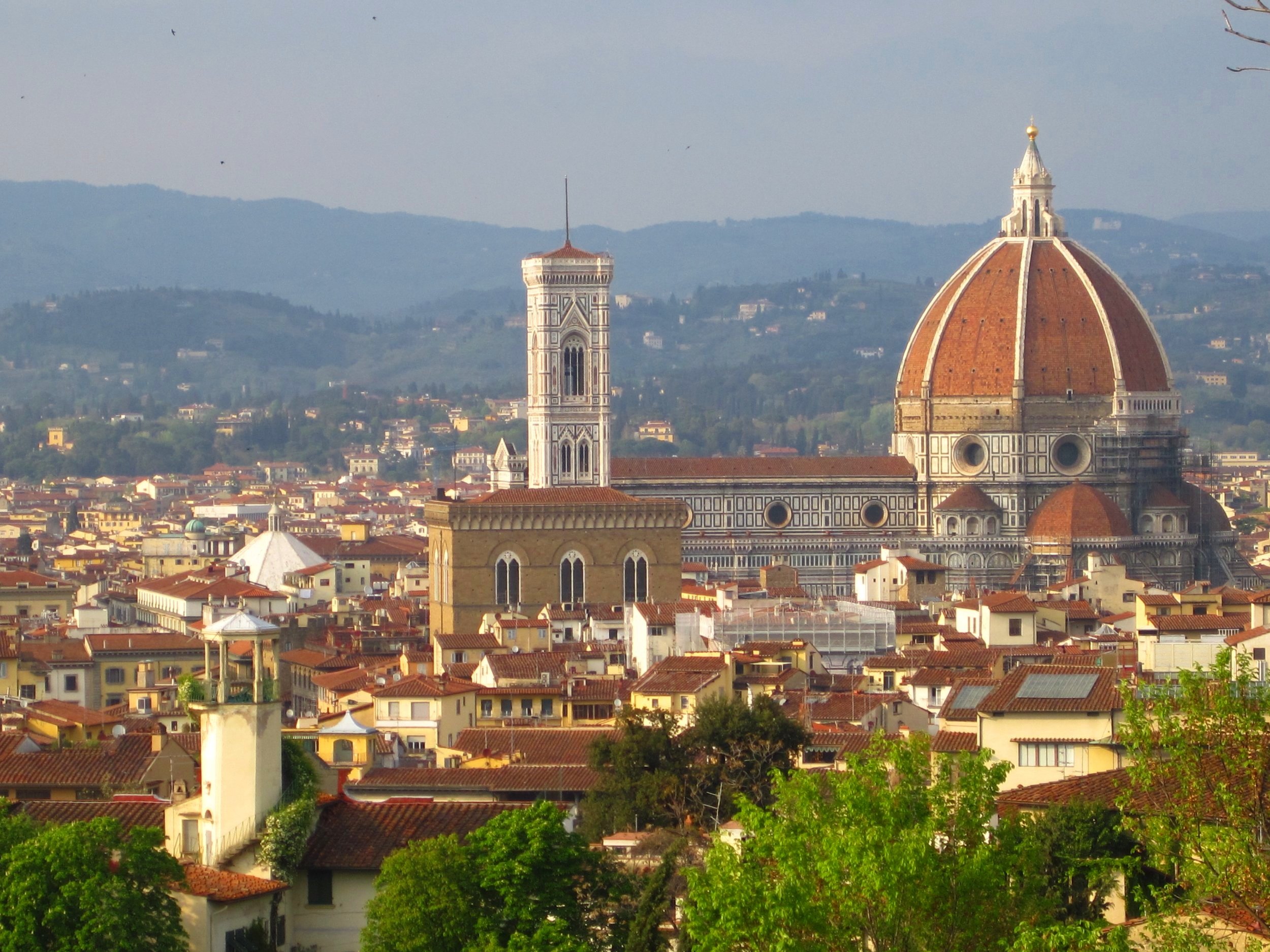Visiting The Boboli Gardens (with kids)
Visiting the Boboli Gardens in Florence is an enchanting getaway amongst the chaos of the busy historic center. It is the perfect place to enjoy a picnic with a magnificent view, read a book while you sit by an ancient fountain, or stroll through the light and shadows in a labyrinth of trees. It is also a wonderful place to take kids when you are traveling to get out some wiggles. After restaurants and museums the gardens feel incredibly open and freeing for the little ones. And since the gardens are so vast you feel as though you can let them be a bit more active without worrying too much about disturbing other people. Plus there are so many nooks and crannies to discover here it can be a great adventure for them…and you!
The area where The Boboli Gardens and the Pitti Palace now sit was originally purchased in 1418 by Luca Pitti and later sold to the Medici in 1549. The gardens were designed for Duchess Eleonora of Toledo ( wife of Cosimo I de' Medici) and the works began in 1550 and then spanned over 400 years as the family continued to turn this green space into the beautiful open air museum that we see today. The Medici family created the stylish and elegant layout of the gardens that would become a model for many European Royal gardens, in particular, Versailles in France. The gardens, which have been open to the public since 1766, span over 111 acres and are adorned with ancient Renaissance and Roman statues and unique grottos, including the famous Buontalenti grotto by Bernardo Buontalenti. There are also many wonderful fountains, such as the Fountain of Neptune, Monkey Fountain and the Fountain of the Ocean.
Main Sites to See at the Boboli GardENS
ANFITEATRO DI BOBOLI (THE BOBOLI AMPHITHEATER) -
This amphitheater was designed for Eleonora di Toledo and built in 1550. The amphitheater sits on the original site of the quarry that supplied the material for building the Pitti Palace. It was called Anfiteatro di Verzura because it was designed to be an amphitheater of greenery. This site was the setting for many wonderful events, festivals, parades, plays and performances. There may have been many changes and restorations to the amphitheater over the years but it is said to be very similar to how it would have looked during the mid 1600’s.
VIALE DEI CIPRESSI or VIOTTOLONE (CYPRESS LANE) -
The main walk way that leads from the upper area of the gardens down to the Ocean Fountain is called Viale dei Cipressi or Cypress Lane. It is lined with trees and cypresses and gives way to many little tree lined walkways, gardens and hidden pathways. Heading down the hill towards the Fontana dell'Oceano you will find the Tiny Birds Fountain to the left and to the right La Fontana dei Mostaccini, the Lemon House and La Fontana della Vendemmia to the right.
CERCHIATE (BRANCH ARCHWAYS) -
These branched archways are one of my favorite parts of the Boboli Gardens! The light dances and sparkles through the leaves while you are strolling along and it is so romantic. You can’t help but feel like you’ve stepped back in time or into some fairytale story. The kids love this part too because there are so many paths to take and secret spots to explore! Head down Cypress Lane and take a left or right when you see the archways or hidden pathways.
PALAZZINA E BASTIONE DEL CABALIERE (KNIGHT’S BUILDING & RAMPART AND PORCELAIN MUSEUM) -
This building and it’s gardens sit on the Rampart that was built during the siege of Florence between 1527-1530. The double staircase leading up to the charming circular terrace was added in the 1790’s. The building and the Boboli Gardens (in part) were named for Knight Malatesta Baglioni that originally lived there. This is honestly my most favorite part of the Boboli Gardens. The Palazzina’s façade along with it’s courtyard, gardens and Monkey fountain are just enchanting! And the view!…breathtaking! I could live very happily here :) Take some time to soak in all the beauty. Make sure to step inside the Palazzina when the Porcelain Museum is open. Its lovely!
LA LIMONAIA (LEMON HOUSE) -
The Lemon House was built between 1777 and 1778 in the former location of a zoo with exotic animals that was built by Grand Duke Cosimo III de’ Medici in 1677. Today it is still in use and houses around 500 citrus plants from the Gardens. I have actually never taken the time to step into the Limonaia. I’ve just always kind of admired it from afar. Next time I’ll have to check it out!
THE FOUNTAINS AND STATUES -
One of my favorite things about Italy are all of the fountains and drinking fountains. They add so much beauty and tranquility to the world. They are refreshing to all of the senses and have a way of transporting any negative emotions to a calmer happier place. I think it is easy to take them for granted when we are sightseeing, but if you stop for a minute and truly take them in… it’s magical!
The Boboli Garden Fountains - There are some lovely ones here for sure! If you enter through the Pitti Palace one of the first fountains you will see is La Fontana del Carciofo (artichoke fountain). I love this fountain! The only bad thing about it is that you can get very close to it. I’d love to see it’s details so much better. Moving forward you will head through the amphitheater and on up the hill to the Fountain of Neptune. Head up further and you will come to The Knight’s building on the Rampart where you can see La Fontana delle Scimmie (Monkey Fountain). This is my favorite area and I love this pleasant little fountain! Heading over towards the Kaffeehaus you will find the Fontana di Ganimede (Ganymede Fountain) along with lovely view! The other fountains are going to be as you head down Cypress Lane. At the end of the lane you will come to La Fontana dell’Oceano (Ocean Fountain). This is such a wonderful spot for a pause to enjoy all the history and beauty around you! To the right you can walk just a short distance to the sweet little Fontana della Vendemmia (Grape Harvest Fountain). Off to the left there are two other fountains - Tiny Birds Fountain and La Fontana dei Mostaccini (Mostaccini Fountain). This fountain runs along the sloped pathway. This type of fountain is one most magical ever created I think. Sadly I have never seen one with water flowing. The water would start at the top of the slope and stair step down through the fountains to the bottom. Sooo amazing!
The Boboli Garden Statues - The gardens are spotted with many different types of statues. Some of them are right out in the open and some of them are hidden among the trees and gardens. Two of my favorites are Ghiacciaia (my mom took a picture of this on our trip to Italy together. It hang in our Italian coffee shop and it reminds me of her and those days together) and the elegant Statue of Abundance and the top of the hill. There are many other incredible works of art here too though including, an Egyptian Obelisk, Pegasus and Apollo, and the Bathing Venus and Helen & Theseus in the Buontalenti Grotto.
THE GROTTOS -
There are some glorious grottos in the Boboli Gardens. These are something so unique, and I hadn’t ever seen anything like them until I came to Italy. Is this type of artwork done anywhere else in the world? The grottos include the Grotto of Adam and Eve from 1817 by Giuseppe Cacialli, the Grotta di Madama (Madama Grotto) from 1553-1555 by Davide Fortini, a small grotto at the Kaffeehaus, and then there is the largest and most spectacular grotto, The Buontalenti Grotto (also called “Grotta Grande”) from 1557 – 1587 by Bernardo Buontalenti. This grotto is just something you need to see for yourself. It is so unique, delicate, intricate and beautiful!
KAFFEEHAUS -
The Kaffeehaus is a later addition to the gardens. The works were commissioned by Grand Duke Peter Leopold of Lorraine and carried out between 1774 and 1785. This unique building was meant to be a resting place where the court could pause for some refreshments and to enjoy the fabulous views. It sounds as though it is quite beautiful inside but I have never been there when it is open.
THE VIEWS -
The Boboli Gardens have some breathtaking views of Florence and it’s surrounding areas. It’s no wonder the Medici had to have this perfect piece of property. You can catch the views of the Duomo and Florence from many different places in the gardens. The first is right after you enter the gardens from Palazzo Pitti. It will be off to your left as you stand facing the amphitheater. The second fantastic view is from the gardens in front of the Kaffeehaus and from the Kaffeehaus itself. The third view is from the lovely large open grassy area of the Chestnut Meadow. There are also views from the top of the hill by the Statue of Abundance and then even farther up when you climb the steps to the Ramparts. The view from the Ramparts is the opposite direction from the historic center and it looks like it just jumped out of a Renaissance painting!
When and how to visit the boboli Gardens
WHEN TO VISIT THE BOBOLI GARDENS?
I have been to the Boboli Gardens many times and they are always lovely….but if you are able to visit in the Spring (April and May) I do think they are at their most magnificent! The flowers are blooming, the greenery is fresh and everything feels more vibrant and cheerful.
Obviously the weekends, especially in high season, and anytime admission is free (the first Sunday of the month) are going to be the busiest times to visit, but the gardens are so big it often doesn’t feel crowded except for at a few places where everyone want to capture a photo. That being said, I have never been in July and August. I could see how it could be crazy at this time with tourists trying to escape to a green space and maybe to the shade of tree.
HOW TO VISIT THE BOBOLI GARDENS?
The Boboli Gardens are located in the historic center of Florence, just south west of the Ponte Vecchio and right behind the Pitti Palace. You would never know that such an expansive and beautiful space is sitting right behind the cold stone façade of the palace.
The cost is just 10 euros (lower in the off season) per person and kids 18 and under are free. Pretty amazing if you consider how costly things are these days. This is one of the things I love about Italy. If you have to pay to see certain parts of it’s history at least it is affordable. If you are interested in visiting the Pitti Palace along with the gardens you can get a combo ticket for 22 euros (lower in the off season) per person.
Tickets can be purchased at any of the 4 entrances (see map below - black dot with two arrows). The main and largest entrance is at the Pitti Palace. The Biglietteria (ticket office) is off to the far right of the front entrance. This entrance is going to have the longest lines and wait time. The other entrances are all less known and so will have less people. If you don’t feel like waiting and can plan your trip in advance then you can purchase your tickets online as well as reserve an entrance time. Visit the main Boboli Gardens website >>HERE<<. This is a must during high season! At the same website you can also purchase tickets for The Pitti Palace, The Uffizi Gallery and The Vasari Corridor. Link to the map below in more detail >>HERE<<
HOW LONG DO YOU NEED AT THE BOBOLI GARDENS?
This obviously depends on the person but I would say if you visit both the palace and the gardens you could easily spend 5 or 6 hours or more. I like to give the gardens at least 3 hours. You will not be able to cover all of them in this time but you will get to see most of the highlights. They are so large I feel like it’s too much for one visit…especially if you have kids! I have never made it through every inch of the place in one trip.
WHAT SHOULD YOU BRING and WHAT SHOULD YOU KNOW?
There are some drinking fountains here but not a lot so I would definitely suggest bringing water, and bring extra if it is during the hotter months. It is a must to bring snacks in as well. There isn’t a restaurant here like at Villa Bardini. There probably should be because it would do amazing! There is a bar/restaurant in the Piazza of the Palazzo Pitti but when you are deep in the gardens a walk back down to the Palazzo can be too much! Bring in your own goodies or grab something at the bar and have a fabulous picnic with a view :)
Restrooms are located by the amphitheater and at the top of the gardens. The map (above) shows that there are restrooms at the entrance near the Limonaia, at the entrance near Fort Belvedere and near the Porcelain Museum. Since I have never seen any of these restrooms I can’t confirm that they are there and open. The one at the top of the hill near the open grassy area (Chestnut Meadow) has always been open and going so you should be able to count on that. If you have little ones take advantage because once you head down the hill towards the Ocean Fountain there may not be anything convenient.
Walking and climbing - There is a lot of uphill walking and steps at the Boboli Gardens. If you have mobility issues it can be a difficult place to visit. The gardens are built on a pretty good incline and there are lots of steps but there are also ways to get around without taking the steps if needed.
Best way to see the gardens - To minimize going back and forth and going up too many hills, I like to enter at the Pitti Palace and visit everything to the left including the grottos to the lower left and the Kaffeehaus and it’s gardens. Then you can take one of the paths to head over and visit the amphitheater. After this head up the hill, enjoying the fountains as you make your way up to the Statue of Abundance and the Ramparts. After the Ramparts, visit the grassy area of the Chestnut Meadow. After this, head down the hill on Cypress Lane towards the Ocean fountain. Along the way visit the Lemon House, the branched archways and the all of the other gardens along the way. When you are ready to go you can exit through the Annalena exit (near the lemon house) or the Porta Romana exit. After that all you have to do is walk back through the flat streets towards the Ponte Vecchio.
Open Hours of the Boboli Gardens -
The gardens are open 7 days a week.
Opening hours vary throughout the year:
January-February and November-December: 8.15am – 4.30pm
March-May and September-October: 8.15am – 6.30pm
June-August: 8.15am – 7.00pm
The gardens are closed on the first and last Monday of the month (except in the summer when it never closes), January 1st and December 25th.
Buon Viaggio :)













































